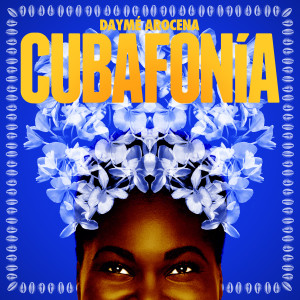 There’s a lot more to Latin music than the cumbia, salsa, samba and Cuban son that North Americans are familiar with. Cuban diva Daymé Arocena covers a lot of sonic territory on her second album, Cubafonía.
There’s a lot more to Latin music than the cumbia, salsa, samba and Cuban son that North Americans are familiar with. Cuban diva Daymé Arocena covers a lot of sonic territory on her second album, Cubafonía.
Drawing on the rich mix of regional and local styles, Daymé has filled this album with catchy melodies and rhythms of the fast-paced changüí, the popular guaguancó and ‘70s-style balladas, backed by a big band and a lively rhythm section.
The first time I heard the infectious “Mambo Na’ Mà” I almost stood up and started dancing. Fortunately, I was able to control myself, because I was driving down the freeway at 70 mph at the time. It’s an incredible blend of Afro-Cuban rumba, R&B, hip-hop, New Orleans second line and even hard bop, particularly in the powerful baritone sax line that drives the rhythm. It opens with Daymé soulfully and sexily scat-singing and just gets better from there. If there’s any justice, “Mambo Na’ Mà” should be one of the dance hits of the year everywhere on this planet, and maybe on one or two others as well.
If you like dance mixes, check your favorite streaming service for the “Mambo Na’ Mà” single, which has a club mix on the flip side.
The whole album pulls from Cuba’s rich musical legacy. Daymé sings mostly in Spanish, but drops effortlessly into a fluent English and even occasionally into a bit of French. The opening track “Eleggua” perhaps telegraphs the album’s overarching theme, with its evocation of Yoruban religion and the ubiquitous clave rhythm with its blend of European and Caribbean influences. With its near-symphonic density, soaring choral vocals and driving horn section, it also echoes Kamasi Washington’s immensely popular 2016 release The Epic.
A cha-cha rhythm underlies the equally infectious “Lo que fue,” a lush mid-tempo ballad with soaring chorus. It also introduces a wonderful old-school sound with a couple of different organs, which also show up on the percolating descarga “Negra calidad.”
“La rumba me llamo yo” at heart is a straight Cuban rumba, but it too pulls in lots of other influences. The jumpy opening section (not to mention the stupendous complex bass line throughout the song) put me in mind of early works by Portland, Oregon’s Esperanza Spaulding with their blend of rock, jazz and Latin sounds and rhythms.
I don’t want to overlook the lush, romantic ballads like the bilingual “Cómo,” which is very much American R&B with some Latin flavor; the softly acoustic but soulful “Todo por amor”; or the dark, jazzy “Angel.”
The term “tour de force” is overworked and overused, but Cubafonía is just that, an impressive display of Daymé Arocena’s chops as a singer and her depth as an interpreter and extender of Cuban musical tradition. If you like Cuban or any other Latin music, or even if you’re just curious about it, you need Cubafonía.
(Brownswood, 2017)
